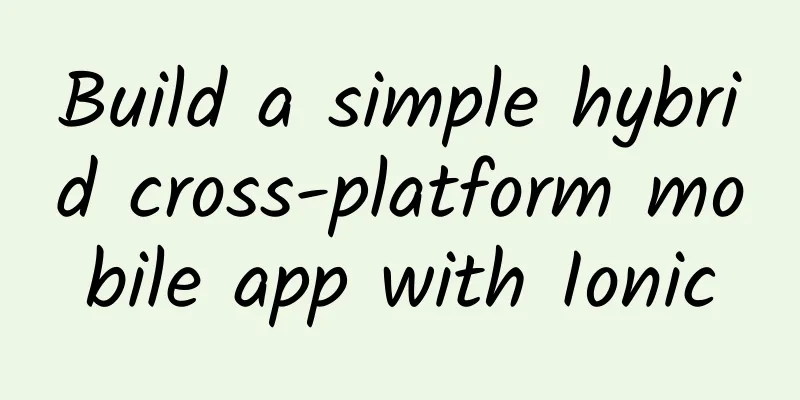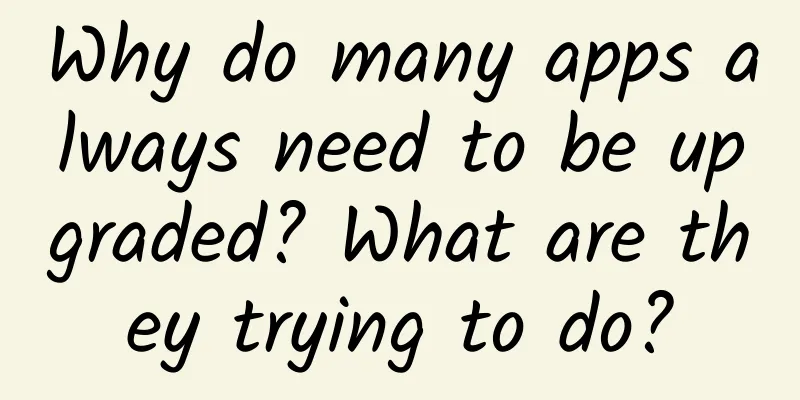Build a simple hybrid cross-platform mobile app with Ionic

|
introduce Since hybrid mobile development became popular, some web engineers have begun to switch to mobile development. Hybrid mobile development technology allows web engineers to develop mobile applications for various platforms without having to learn the native programming languages of each platform. There are already many hybrid development platforms such as PhoneGap and Titanium to help us with hybrid programming. Today we are going to introduce a newer hybrid mobile development platform, Ionic. Ionic is an advanced HTML5 hybrid mobile application development framework and an open source front-end framework. Ionic applications are based on Cordova, so Cordova-related tools can also be built into the application. Ionic focuses on visual effects and user experience, so AngularJS is used to build a variety of cool effects. Install To get started with Ionic development, you need to install Node.js. Then install the corresponding Android or IOS platform according to your development environment. In this article, we will create an Android application. Next you need to install a Cordova and Ionic command line tool, as follows:
After the installation is complete, you can try to start creating a project:
Enter the project directory, add the ionic platform, create an application, run it in a virtual machine, and become tall, rich and handsome...
Here is the sample application effect: start We've got a good start, now let's create a ToDo list app. We start with the blank template:
If you go into the project directory, you will see the AngularJS file, this is where we will add the relevant code. Creating and displaying listsFirst, you need to add a list to your application. We will use ion-list directly. Add ion-list to www/index.html:
Then let's take a look at what our HTML file looks like after adding ion-list:
Then we can create a controllers.js file in www/js/ to define a new cntroller, we will call it ToDoListCtrl for now. Here is the content of the controllers.js file:
In the above code, we defined a module called starter and a Controller called ToDoListCtrl. Then we need to add this module to our application. Open www/js/app.js and add the module:
Let's go ahead and define a $scope to carry the items in the ToDo list. Declare a new $scope variable in ToDoListCtrl as follows:
Add controllers.js to index.html:
In the code above, we added bar-positive to add color to the application. You can add many different headers in the same way. There is detailed documentation here: here. We now need to add a button in index.html to trigger the event:
Now let's confirm that in the above operation, we added a header, an input box and a button to the modal. We also need a back button in the header, which is used to trigger the closeModal() function. Now we start binding ionic modal to our controller. We inject $ionicModal into the controller as follows:
In the above code, we use .fromTemlateUrl to load the HTML content, and then define the $scope and animation types through two options during initialization. Of course we also define methods to open and close the moda and add items to the array. run Okay, everything is ready, let’s start the virtual machine. It looks good, right? Summarize In this article, we have seen a rough process of using Ionic. You can see the detailed code here. If you want to learn more, you should learn more about AngularJS. Reference: If you are interested, you can read this basic AngularJS development tutorial: Introduction to Practical Programming of AngularJS Development Framework Part 1 via sitepoint |
<<: Chinese Internet companies may join forces to give Apple an embarrassing problem
>>: Apple is rumored to be planning a new 4-inch iPhone in 2015
Recommend
Ximalaya FM Product Experience Analysis Report (Part 1)
As the largest audio platform in China, Himalaya ...
"Nezha 2" has exceeded 10 billion box office! These three types of people are not recommended to watch the 3D version
Review expert: Peng Guoqiu, deputy chief physicia...
So sweet! Science paper confirms that "love existed before the Christian era"
"My love for you was written in BC and burie...
How to promote a new App?
Since I often write about App promotion, friends o...
Are water-heated blankets and zoned control just a waste of money? How to choose an electric blanket?
It's the season again when getting up require...
ChatGPT is almost one year old! How did it develop such fluent conversation skills?
ChatGPT will be one year old in November this yea...
How can brands break through marketing bottleneck?
An entrepreneur opened an overseas flagship store...
These car ads never disappoint.
Claude C. Hopkins, the father of modern advertisi...
How did NetEase's "Terminator 2" become popular in the App Store within a week?
"No matter how you hide, how you run, in the...
How to increase the number of followers by 30,000 in one month without any hot spots?
The Double Eleven shopping carnival has passed, a...
2022 Chengdu Tea Tasting Resources Drinking Tea Sharing Navigation Guide Those who have been here are full of praise [Sincere Night View]
Chengdu tea tasting resources: Senior agent Night...
A fresh stream in the live broadcast industry, celebrities’ live broadcasts should be the transmitters of positive energy
When it comes to online live streaming, Internet ...
Unveiling Omicron: Will it be the last coronavirus variant to wreak havoc around the world?
Written by: Zhu Hengheng Editor: Wang Haha Layout...
A "time capsule" from outer space is right here on Earth
About 4.5 billion years ago, the solar system was...
[Guangming Museum Drawing] There are some tips for “drawing fish”: taking the coral reef fish of the South China Sea as an example
The South China Sea is the most biologically rich...









